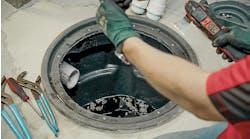One of our first introductions to water-jetting sewer drain-line cleaning machines took place while a commercial high-pressure jetter was on site cleaning the downstream side of a parking lot grease trap. The building’s food court PVC drain line left the building to enter a large 1,500-gallon grease trap and returned to rejoin the building’s sewer line via 4-in. PVC. The reentry point is located in an access corridor used by employees to receive shipments and/or move about the building. While walking along the corridor, several women suddenly were confronted by what looked like an angry snake spewing water jets that chased them down the hallway. The water jetter’s high pressure had proven to be too much for the PVC sanitary-T and had blasted its way through the back of the Tee. A few seconds earlier, the head of the jetter’s hose would have blasted its way directly into the group walking along the corridor. We replaced the Tee with a combination Y&1/8-bend. Since that time, we have purchased water-jetting sewer drain-line cleaning equipment. That same line has been cleaned repeatedly without incident.
Grease, in particular, had always been a challenging issue for standard drain cleaning cable-style equipment. The cables return covered with goo that seems to defy cleaning. Cleanup of the area is no picnic. No matter how much care you exercise, clothing and hands are treated to black goo with awesome stain potential that defies washing away. Gloves worn to protect hands need to be rigid enough that they cannot become wound and tangled around a spinning cable — a fast way to break finger(s). The large drum-style machines also excel at flinging a wide arc of darkened liquid from floor-to-wall-to-ceiling before you can get your foot off of the pressure switch.
Soft stoppages are no match for water jetters. The prospect of cleaning as you go and pulling back a fairly clean hose holds lots of appeal. At 1.5-gal. per minute for the smaller 1,350-PSI jetter, however, the drain line had better be partially open or you’ll find you’re creating a flood within the kitchen cabinet.
Combining both types of sewer drain cleaning equipment (mechanical-cable and water-jet) enables you to enjoy great flexibility for attacking all types of stoppages. If the drain is completely clogged and overflowing, water will cause damage. Drilling through the stoppage clears a path for using the jetter. For frozen drain lines, jetter machines provide an excellent and fast way to blast away the ice-dam. A wet/dry shop vacuum can be used to avoid water damage from overflowing drains while using the jetter.
Root-cutting heads are available for many of the high-pressure jetters available to the trade, which brings up an issue often overlooked — operator safety. At 40,000 PSI, water-jetting equipment is utilized to cut through steel. At 1,350 to 17,000 PSI, water jetters in use for drain-line cleaning can cut through human flesh before the operator can react. In many cases, that high-pressure jet will include contaminated water that can be blasted into deep wounds like a gunshot. If you or one of your employees is injured by water jetting equipment, it is imperative the attending physician understands the nature of the injury and that contaminants may be deeply embedded in the wound. Most of the water-jet hoses are sufficiently flexible that you need to insert them far enough into the drain line to prevent splash-back or to keep from being hit by the nozzle’s spray. Retrieving the hose and nozzle, the operator likely will be running at full pressure to give the drain its final cleaning. Extreme care must be exercised when the last few feet are being pulled back. There is an ever-present potential for serious injury and death caused by hoses that whip-saw freely once out of the drain line’s confined space.
Jetters can suffer freeze damage quickly during transport or while idling in freezing weather. Using a jetter can increase the risk of slipping and falling while working on greasy surfaces (commercial kitchens) or in areas where ice can form.
The work you do is vitally important to the welfare and safety of your customers — and often underappreciated. Work safely and charge more. Your services are worth every penny.
Dave Yates owns F.W. Behler, a contracting company in York, Pa. He can be reached by phone at 717/843-4920 or by e-mail at [email protected]
All Dave Yates material on this website is protected by Copyright 2008. Any reuse of this material (print or electronic) must first have the expressed written permission of Dave Yates. Please contact via email at: [email protected]

